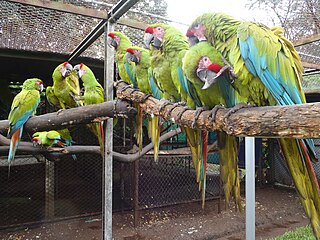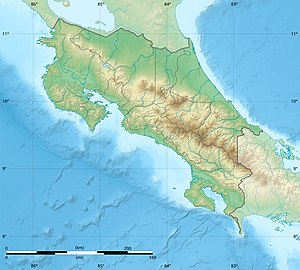Maquenque Wildlife Refuge, is a protected area in Costa Rica, managed under the Arenal Huetar Norte Conservation Area, it was created in 2005 by decree 32405-MINAE.

The great green macaw, also known as Buffon's macaw or the great military macaw, is a critically endangered Central and South America parrot found in Nicaragua, Honduras, Costa Rica, Panama, Colombia and Ecuador. Two allopatric subspecies are recognized; the nominate subspecies, Ara ambiguus ssp. ambiguus, occurs from Honduras to Colombia, while Ara ambiguus ssp. guayaquilensis appears to be endemic to remnants of dry forests on the southern Pacific coast of Ecuador. The nominate subspecies lives in the canopy of wet tropical forests and in Costa Rica is usually associated with the almendro tree, Dipteryx oleifera.
Ostional Mixed Wildlife Refuge, is an 85.7 km2 (33.1 sq mi) Wildlife refuge of Costa Rica, part of the Tempisque Conservation Area, was originally declared a protected area in 1982, and its status has been changed several times since then, including covering a larger area both on land and out to sea. It was created to protect important nesting beaches of the Olive ridley sea turtle.

Caribbean La Amistad Conservation Area is an administrative area which is managed by SINAC for the purposes of conservation in the eastern part of Costa Rica, on the Caribbean coast. It contains several national parks, and a number wildlife refuges and other types of nature reserve.
Talamanca is a canton in the Limón province of Costa Rica. The head city is Bribri, located in Bratsi district.
Formed in December 1999, Acción de Lucha Anti-Petrola (ADELA) is a Costa Rican grassroots environmental group created to oppose offshore oil exploration and drilling. Translated into English as "Anti-Petroleum Action," ADELA is named after a local indigenous woman who was "struggling to defend her culture and local environment against outside forces." ADELA initially consisted of 30 local citizen's groups ranging from farmers' organizations and the fisherman's union, to religious groups, small business owners, and marine biologists. ADELA now comprises over 100 local citizens' organizations. The various groups came together to form ADELA after becoming aware of the negative environmental impact of seismic reflection explorations being conducted by Harken Costa Rica Holdings in November 1999.

Puerto Viejo de Talamanca is a coastal town in Talamanca in Limón Province in southeastern Costa Rica, known simply as Puerto Viejo to locals. The town was originally called Old Harbour until the Costa Rican government institutionalized Spanish as the national language and changed the names of the towns and landmarks in the area from English to Spanish or Native American. Fields became Bri Bri. Bluff became Cahuita. There is another town commonly known as Puerto Viejo in northeastern Costa Rica, Puerto Viejo de Sarapiquí, which can confuse visitors. Buses leaving the same San José station for either of the Puerto Viejos display the same destination, "Puerto Viejo".

Cahuita is a district of the Talamanca canton, in the Limón province of Costa Rica. It is located on the Caribbean coast.

The Ara Project was an NGO and former zoo run by a retired United States expatriate couple that existed in from the 1980s to 2008 as a private zoo under the name Amigos de las Aves. It was re-branded from 2009 to 2018 as "The Ara Project" with the goal of conserving the two native macaw species of Costa Rica: the great green macaw, known locally as lapa verde, and the scarlet macaw, known locally as lapa roja. It has since re-branded again.

Jairo Mora Sandoval was a Costa Rican environmentalist who was murdered while attempting to protect leatherback turtle nests. Just before midnight on May 30, 2013, Mora and four female volunteers were abducted by a group of masked men. The women eventually escaped and informed the police. Mora's bound and beaten body was found on the beach the next morning. An autopsy determined he died by asphyxiation after suffering a blow to the head.

Anacristina Rossi is a Costa Rican writer.
Caletas-Ario Mixed Wildlife Refuge, is a protected area in Costa Rica, managed under the Tempisque Conservation Area, it was created in 2006 by decree 33232-MINAE.
Golfito Mixed Wildlife Refuge, is a protected area in Costa Rica, managed under the Osa Conservation Area, it was created in 1986 by decree 16912-MAG.
Osa Mixed Wildlife Refuge, is a protected area in Costa Rica, managed under the Osa Conservation Area, it was created in 1999 by decree 27922-MINAE.
Preciosa-Platanares Mixed Wildlife Refuge, is a protected area in Costa Rica, managed under the Osa Conservation Area, it was created in 1998 by decree 26825-MINAE.
Quillotro Mixed Wildlife Refuge, is a protected area in Costa Rica, managed under the Osa Conservation Area, it was created in 1999 by decree 27923-MINAE.
Rancho La Merced Mixed Wildlife Refuge, is a protected area in Costa Rica, managed under the Osa Conservation Area, it was created in 1995 by decree 24638-MIRENEM.
La Ensenada Mixed Wildlife Refuge, is a protected area in Costa Rica, managed under the Central Pacific Conservation Area, it was created in 1998 by decree 27211-MINAE.
Portalón Mixed Wildlife Refuge, is a protected area in Costa Rica, managed under the Central Pacific Conservation Area, it was created in 1996 by decree 25139-MINAE.

The Bocas del Toro-San Bastimentos Island-San Blas mangroves ecoregion covers the mangrove habitats along the Caribbean Sea coast of Costa Rica and across the northern coast of Panama. An offshore reef and barrier islands of the region help protect the mangroves from destructive waves. The ecoregion has a high number of endangered and threatened species, including the loggerhead sea turtle, green sea turtle, and hawk's bill sea turtle.












